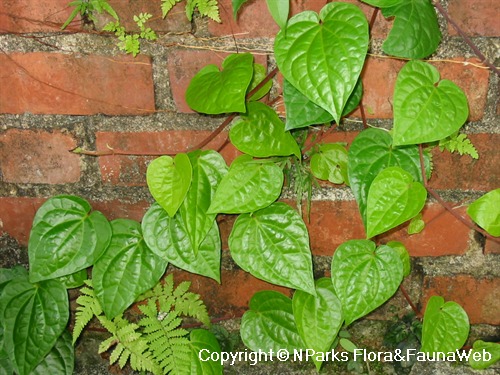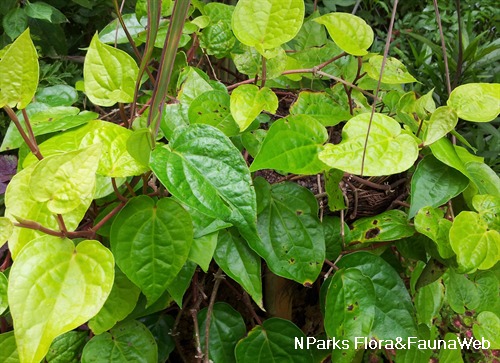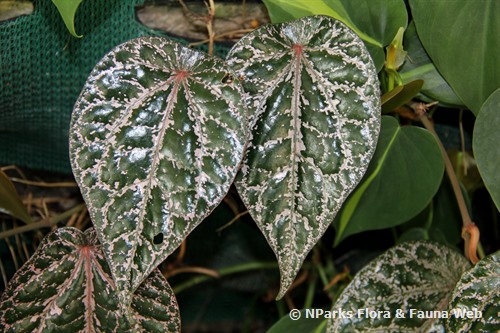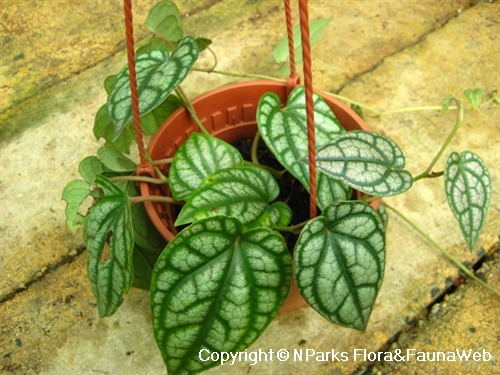
Back
Piper betle L.
| Family Name: | Piperaceae |
| Synonyms: | Piper siriboa L. |
| Common Name: | Betel, Betel Vine, Betel Pepper, Betle Pepper, Pan, Sireh |
Piper betle, known as Betel or Sireh is a climbing vine with glossy, heart-shaped leaves. This plant is usually cultivated for its leaves where in some countries, they are chewed with slaked lime and in some others, they are used as traditional herbal medicine or for prayers.
Name
Classifications and Characteristics
| Plant Division | Angiosperms (Flowering Seed Plants) (Dicotyledon) |
|---|---|
| Plant Growth Form | Climber |
| Lifespan (in Singapore) | Perennial |
| Mode of Nutrition | Autotrophic |
| Maximum Height | 3 m to 4.5 m |
Biogeography
| Native Distribution | Bali, East Indies |
|---|---|
| Native Habitat | Terrestrial |
| Preferred Climate Zone | Tropical |
| Local Conservation Status | Non-native (Spontaneous (Casual)) |
Description and Ethnobotany
| Growth Form | A semi-woody branching vine with a sprawling or climbing growth habit. |
|---|---|
| Foliage | Light green to bright green leaves are glossy, deeply veined and hairless. They are heart-shaped with entire leaf margin. The petiole (leaf stalk) is reddish like the stem. |
| Stems | Round stems are orangish to reddish. |
| Flowers | White catkins developed on the nodes, erect or pendulous. Flowers are small, without sepal and petal. |
| Fruit | Fleshy, globose to ellipsoidal shaped. |
| Cultivation | This species has some drought tolerance, but grows best in fertile, well-drained soil that is kept moist. Propagate by division. |
| Etymology | The genus Piper comes from Sanskrit 'pippali' which means pepper. The specific epithet betle is from the Malayan vernacular name, vettila, for the masticatory leaves, betel. |
| Ethnobotanical Uses | Food (Herb or Spice) Medicinal: Leaf extracts have antimicrobial and antioxidant activity (Nalina and Rahim 2007, Dasgupta amd De 2004). They also promoted glucose metabolism in diabetic rats (Santhakumari et al 2006), but might cause cancer when consumed with lime and areca nut (a popular combination known as piper betel quid). Cultural / Religious: Brass containers of betel nut leaves are swapped to finalized weddings in Bengal. Bride and groom seek blessings from elders by presenting them with betel leaves and areca nuts. Others: The combination of leaves, betel nut (fruit of Areca catechu) and slaked lime has stimulating properties when chewed. In traditional Vietnamese weddings, the groom offers the bride's parents betel leaves and areca nuts as part of the bride price. |
Landscaping Features
| Desirable Plant Features | Ornamental Foliage |
|---|---|
| Landscape Uses | Suitable for Hanging Baskets, Parks & Gardens, Trellis / Arbour / Pergola |
Plant Care and Propagation
| Light Preference | Semi-Shade |
|---|---|
| Water Preference | Lots of Water, Moderate Water |
| Plant Growth Rate | Fast to Moderate |
| Rootzone Tolerance | Moist Soils, Well-Drained Soils |
| Propagation Method | Stem Cutting |
Foliar
| Foliage Retention | Evergreen |
|---|---|
| Mature Foliage Colour(s) | Green |
| Mature Foliage Texture(s) | Glossy / Shiny |
| Prominent Young Flush Colour(s) | Green, Green - Light Green |
| Young Flush Texture(s) | Glossy / Shiny |
| Foliar Type | Simple / Unifoliate |
| Foliar Attachment to Stem | Petiolate |
| Foliar Shape(s) | Non-Palm Foliage (Cordate) |
| Foliar Venation | Pinnate / Net |
| Foliar Margin | Entire |
Non - Foliar and Storage
| Root Type | Aboveground (Aerial Root) |
|---|
Floral (Angiosperm)
| Flower Colour(s) | White |
|---|---|
| Flower Grouping | Cluster / Inflorescence |
| Flower Location | Axillary |
| Flower Symmetry | Radial |
| Inflorescence Type | Spike, Catkin |
References
| References | Suwanphakdee, C., Simpson, D.A., Hodkinson T.R. & Chantaranothai P. (2020). A synopsis of Thai Piper (Piperaceae). Thai Forest Bulletin (Botany) 48(2): 145-183 |
|---|
Image Repository
Others
| Master ID | 194 |
|---|---|
| Species ID | 1490 |
| Flora Disclaimer | The information in this website has been compiled from reliable sources, such as reference works on medicinal plants. It is not a substitute for medical advice or treatment and NParks does not purport to provide any medical advice. Readers should always consult his/her physician before using or consuming a plant for medicinal purposes. |

.jpg)
.jpg)



_lowres.jpg)